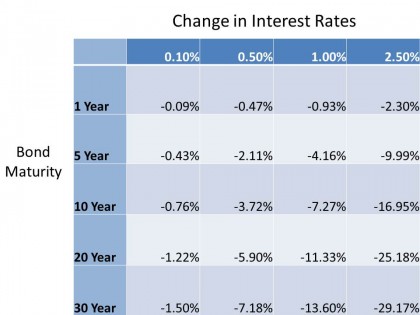Bonds & Interest Rate Risk

I can remember my first experience with interest rates. It was when I purchased a CD from a bank, and I can recall how honest and straightforward the arrangement was – you give the bank your money for an agreed upon amount of time, after which you get your money back plus a little interest for the trouble. If you had confidence that you could do without the money during that period (getting your money back beforehand subjected you to some penalties), it was a great way of making your money work harder for you (my, how things have changed!).
I’ve always thought that CDs are the easiest and perhaps the most common way of understanding interest rates and how they affect bond prices. After all, a CD has the same characteristics as a zero coupon bond (a type of bond that pays all interest at the maturity date of the bond).
Example: Interest Rate Increase
Suppose you went to a bank and purchased a CD that is going to mature in 1 year for $1,000 with a yield of 3.00%, which was the prevailing interest rate at that time. Let’s also assume that you could sell your CD to another investor for cash, making it more like a bond. Now, suppose the day after you purchased the bond interest rates went up to 5.00% and, as a result, the bank now offered the same CD that you purchased the day before at this new, higher interest rate. Well, I am sure that you would not be too pleased because if you had waited just one more day you could have received a much higher return - more specifically, you could have received $1,050 in one year instead of $1,030, putting an additional $20 in your back pocket.
In addition to this “opportunity cost”, there is also a much more direct impact on the value of the CD that you are holding. Just before interest rates increased, the value of the CD was just about $1,000, the amount that you paid for it. Now that interest rates have gone up, no one would be willing to give you $1,000 for the CD that you purchased yesterday because they can always go to the bank and get a higher interest rate than what your CD is providing. So, if you wanted to sell your CD you would have to discount that value to an amount such that the yield is at least equal to what they would get at the bank, or 5%, which translates into a sale price of about $981. So, overnight you lost $19.
The example we just went through illustrates the interest rate risk of bonds – as interest rates increase, the value of a bond decreases for the same reasons and in the same manner described in the illustration; conversely, as interest rates decrease the value of bond increases. It is also worth pointing out that the later the maturity date of the bond, the more the price of a bond changes to a given change in interest rates. The following table shows the percentage change in value of a 5% yielding bond of different lengths to maturity, at different interest rate changes:
For a 1.00% increase in interest rates, a bond maturing in one year will decline in value by 0.93% while a thirty-year bond will decline by 13.60% – an important consideration if you are tempted to invest in longer term bonds to benefit from their higher interest rates.
Bonds and The Beauty of Buy & Hold
Now, an important question to ponder is “does interest rate risk matter”? After all, in the previous example, I can always just hold the CD to maturity and get my $1,030 as I had originally expected. This, in fact, is a very important distinguishing characteristic of a bond portfolio vs. a portfolio of stocks or mutual funds – because the terms of bonds (primarily the interest payments and maturity date) are fixed, if you can buy and hold to maturity knowing what you will get (ignoring the risk of the bond issuer defaulting on their promise). While the value of a bond may fluctuate during its holding period due to interest rate changes, it doesn’t matter, so long as you do not have to sell it prior to its maturity.
What Does this Mean for My Retirement Income Plan?
This example should demonstrate the value of bonds to retirees, who are obviously going to find this “I know what I am getting” characteristic very appealing. Bond Ladders build from this idea by purchasing a series of bonds with different maturity dates so that the timing of the cash generated from the bond portfolio mirrors the income you need at different times in the future. Read my other post on Bond Ladders for more detail. In addition, this property is a critical difference between owning a bond portfolio and investing in a fixed income mutual fund or exchange traded fund – read my post on this topic for more information.
Before jumping too quickly into bond investing, there are several other important attributes of bonds that you should understand. Features such as callability, convertability, credit quality, duration, tax status, and coupon structure can have a significant impact on the cash flows received from the bond, as well as their risk. It is always prudent to have an investment professional take a look at what you are considering doing before implementing.
Posted by
John Bevacqua on October 31, 2011
Filed Under
Share This Post
While the value of a bond may fluctuate during its holding period due to interest rate changes, it doesn’t matter so long as you do not have to sell it prior to its maturity.
 Follow us on Twitter
Follow us on Twitter Follow us on Facebook
Follow us on Facebook